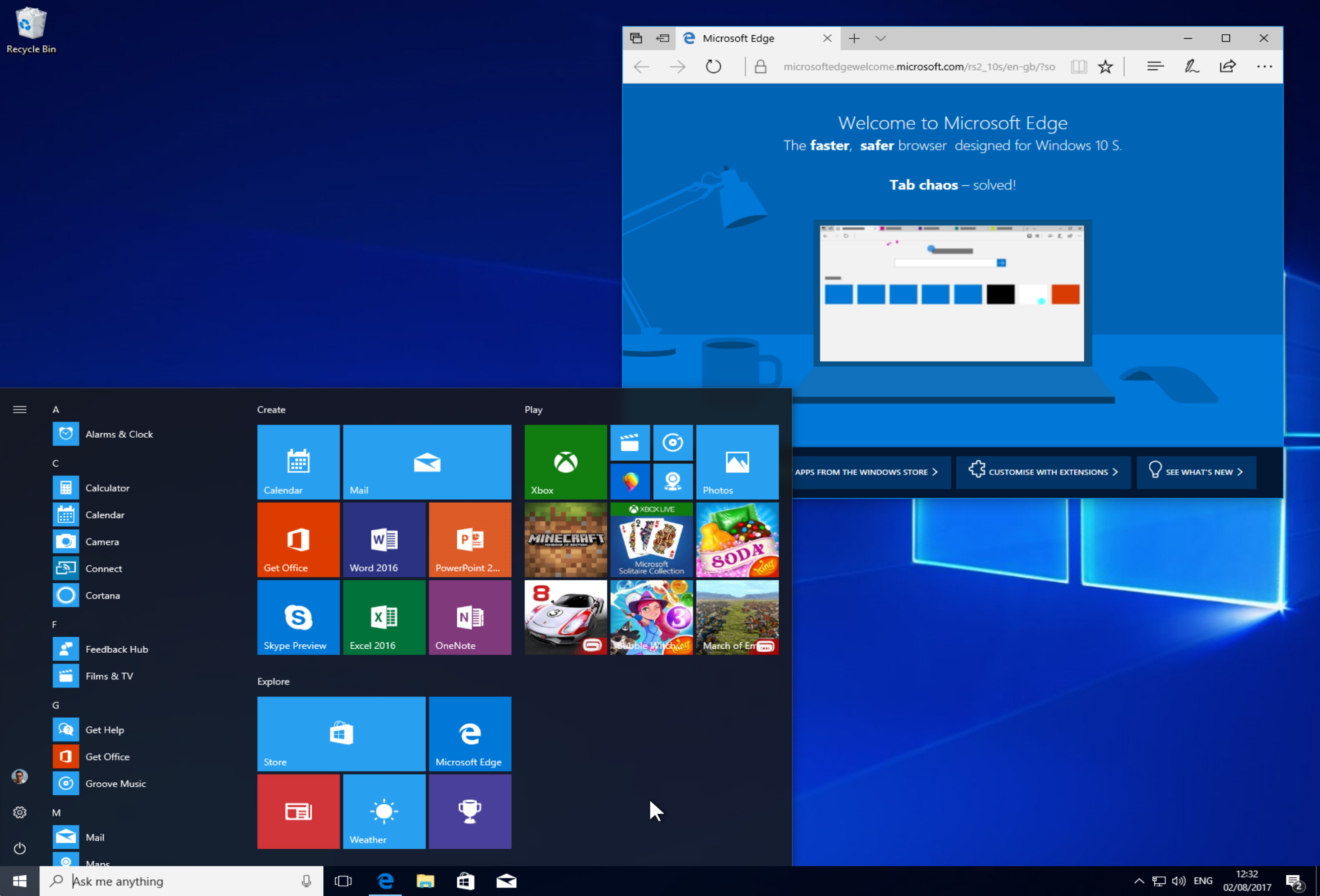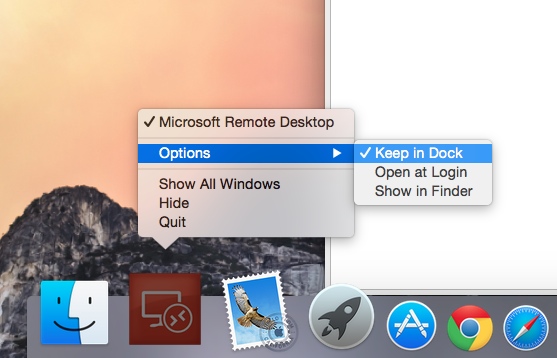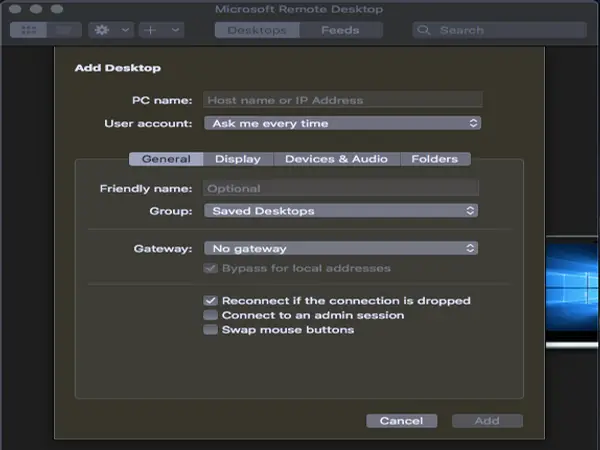Brew Install Microsoft Remote Desktop
- Brew Install Microsoft Remote Desktop For Mac
- Brew Install Microsoft Remote Desktop
- Brew Install Microsoft Remote Desktop Download
- Microsoft Rewards
This section explains how to build the Nextcloud Client from source for allmajor platforms. You should read this section if you want to develop for thedesktop client.
Jan 27, 2020 Even low-cost shared hosts offer MySQL with remote HTTPS or tunneled SSH connections. Docker CE Desktop for macOS Sierra 10.12 and above and Docker CE Desktop for Windows 10. Homebrew’s package index.
- 🍺 A script to bootstrap the install of brew, then install all the applications and utilities I'll need on a new Mac. Mas 'Microsoft Remote Desktop', id.
- Microsoft Remote Desktop 10.3.3 With the Microsoft Remote Desktop app, you can connect to a remote PC and your work resources from almost anywhere. Experience the power of Windows with RemoteFX in a Remote Desktop client designed to help you get your work done wherever you are. License: Freeware Developer/Publisher: Microsoft.
Note
Build instructions are subject to change as development proceeds.Please check the version for which you want to build.
These instructions are updated to work with version 3.0 of the Nextcloud Client.
You have two possibilities to clone the repo.
First option is As [remote URL](https://help.github.com/en/articles/which-remote-url-should-i-use) you can choose between cloning with HTTPS URL’s, which is recommended or cloning with SSH URL’s.
[https://github.com/nextcloud/desktop.git](https://github.com/nextcloud/desktop.git)
When you don’t have SSH key added to your GitHub account, than use HTTPS.

When you no part of the nextcloud organisation, clone with HTTPS:
`$gitclonegit@github.com:nextcloud/desktop.git`
Brew Install Microsoft Remote Desktop For Mac
macOS¶

In addition to needing XCode (along with the command line tools), developing inthe macOS environment requires extra dependencies. You can install thesedependencies through MacPorts or Homebrew. These dependencies are requiredonly on the build machine, because non-standard libs are deployed in the appbundle.

The tested and preferred way to develop in this environment is through the useof HomeBrew. The team has its own repository containing non-standardrecipes.
Brew Install Microsoft Remote Desktop
To set up your build environment for development using HomeBrew:
Install Xcode
- Install Xcode command line tools::
xcode-select –install
- Install homebrew::
/usr/bin/ruby -e “$(curl -fsSL https://raw.githubusercontent.com/Homebrew/install/master/install)”
Add the Nextcloud repository using the following command:
Install a Qt5 version with qtwebkit support:
Install any missing dependencies:
Add Qt from brew to the path:
Where
x.yis the current version of Qt 5 that brew has installedon your machine.Install qtkeychain from here: git clone https://github.com/frankosterfeld/qtkeychain.gitmake sure you make the same install prefix as later while building the client e.g. -
DCMAKE_INSTALL_PREFIX=/Path/to/client-installFor compilation of the client, follow the Generic Build Instructions.
Install the Packages package creation tool.
11. Enable git submodules:`$cddesktop$gitsubmoduleinit$gitsubmoduleupdate`
12. Generate the build files:`$cdbuild$cmake..-DCMAKE_INSTALL_PREFIX=~/nextcloud-desktop-client-DCMAKE_BUILD_TYPE=Debug-DNO_SHIBBOLETH=1`
13. Compile and install:`$makeinstall`
Note

Contrary to earlier versions, Nextcloud 1.7 and later are packagedas a pkg installer. Do not call “make package” at any time whencompiling for OS X, as this will build a disk image, and will notwork correctly.
Windows Development Build¶
Brew Install Microsoft Remote Desktop Download
If you want to test some changes and deploy them locally, you can build nativelyon Windows using MinGW. If you want to generate an installer for deployment, pleasefollow Windows Installer Build (Cross-Compile) instead.
Get the required dependencies:
- Make sure that you have CMake and Git.
- Download the Qt MinGW package. You will use the MinGW version bundled with it.
- Download an OpenSSL Windows Build (the non-“Light” version)
Get the QtKeychain sources as well as the latest versions of the Nextcloud clientfrom Git as follows:
Open the Qt MinGW shortcut console from the Start Menu
Make sure that OpenSSL’s
bindirectory as well as your qtkeychain sourcedirectories are in your PATH. This will allow CMake to find the library andheaders, as well as allow the Nextcloud client to find the DLLs at runtime:Build qtkeychain directly in the source directory so that the DLL is builtin the same directory as the headers to let CMake find them together through PATH:
Create the build directory:
Build the client:
Note
You can try using ninja to build in parallel using
cmake-GNinja../clientandninjainstead.Note
Refer to the Generic Build Instructions section for additional options.
The Nextcloud binary will appear in the
bindirectory.
Windows Installer Build (Cross-Compile)¶
Microsoft Rewards
Due to the large number of dependencies, building the client installer for Windowsis currently only officially supported on openSUSE, by using the MinGW cross compiler.You can set up any currently supported version of openSUSE in a virtual machine if you do nothave it installed already.
In order to make setup simple, you can use the provided Dockerfile to build your own image.
Assuming you are in the root of the Nextcloud Client’s source tree, you canbuild an image from this Dockerfile like this:
Replace
<version>by the version of the client you are building, e.g.3.0 for the release of the client that this document describes.If you do not wish to use docker, you can run the commands inRUNmanuallyin a shell, e.g. to create your own build environment in a virtual machine.Note
Docker images are specific to releases. This one refers to 3.0.Newer releases may have different dependencies, and thus require a laterversion of the docker image! Always pick the docker image fitting your releaseof Nextcloud client!
From within the source tree Run the docker instance:
It will run the build, create an NSIS based installer, as well as run tests.You will find the resulting binary in an newly created
build-win32subfolder.If you do not wish to use docker, and ran the
RUNcommands above in a virtual machine,you can run the indented commands in the lower section ofbuild.shmanually in yoursource tree.
Finally, you should sign the installer to avoid warnings upon installation.This requires a Microsoft Authenticode Certificate
osslsigncodeto sign the installer:For
-in, use the URL to the time stamping server provided by your CA along with the Authenticode certificate. Alternatively,you may use the official Microsoftsigntoolutility on Microsoft Windows.If you’re familiar with docker, you can use the version of
osslsigncodethat is part of the docker image.
Generic Build Instructions¶
Compared to previous versions, building the desktop sync client has become easier. Unlikeearlier versions, CSync, which is the sync engine library of the client, is nowpart of the client source repository and not a separate module.
To build the most up-to-date version of the client:
Clone the latest versions of the client from Git as follows:
Create the build directory:
Configure the client build:
Note
You must use absolute paths for the
includeandlibrarydirectories.Note
On macOS, you need to specify
-DCMAKE_INSTALL_PREFIX=target,wheretargetis a private location, i.e. in parallel to your builddir by specifying../install.Note
qtkeychain must be compiled with the same prefix e.g
CMAKE_INSTALL_PREFIX=/Users/path/to/client/install/.Note
Example::
cmake-DCMAKE_PREFIX_PATH=/usr/local/opt/qt5-DCMAKE_INSTALL_PREFIX=/Users/path/to/client/install/-DNO_SHIBBOLETH=1Call
make.The Nextcloud binary will appear in the
bindirectory.(Optional) Call
makeinstallto install the client to the/usr/local/bindirectory.
The following are known cmake parameters:

QTKEYCHAIN_LIBRARY=/path/to/qtkeychain.dylib-DQTKEYCHAIN_INCLUDE_DIR=/path/to/qtkeychain/:- Used for stored credentials. When compiling with Qt5, the library is called
qt5keychain.dylib.You need to compile QtKeychain with the same Qt version.
WITH_DOC=TRUE: Creates doc and manpages through runningmake; also adds install statements,providing the ability to install usingmakeinstall.CMAKE_PREFIX_PATH=/path/to/Qt5.2.0/5.2.0/yourarch/lib/cmake/: Builds using Qt5.BUILD_WITH_QT4=ON: Builds using Qt4 (even if Qt5 is found).CMAKE_INSTALL_PREFIX=path: Set an install prefix. This is mandatory on Mac OS
